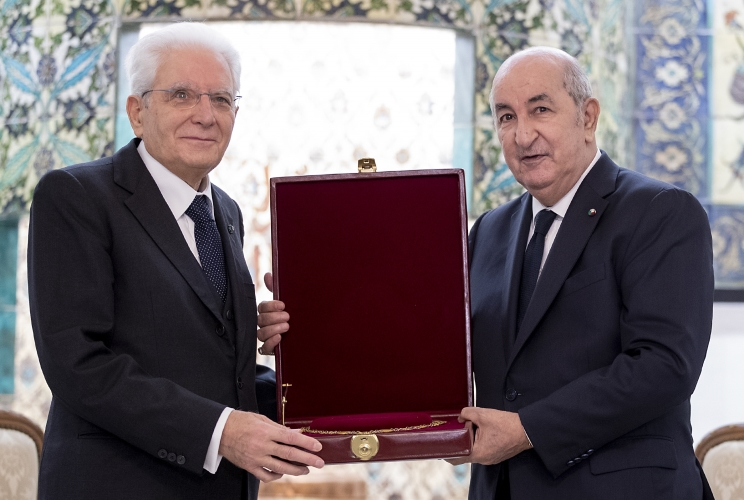
“Chronic Instability” Atop Algerian Military’s Foreign Intelligence and Security Directorate
By Lucas Winter
The Algerian military seems plagued by internal rifts that negatively affect leadership and cohesion. Some evidence of this can be found in what the widely read Moroccan news website Le360 characterizes as"chronic instability" atop Algeria's foreign intelligence and security agency, the General Directorate of Documentation and External Security (DGDSE).

President of the Democratic People’s Republic of Algeria Abdelmadjid Tebboune (2021).
…a politico-military regime… which cuts off heads instead of questioning the structural reasons for its inadequacy.
The Algerian military seems plagued by internal rifts that negatively affect leadership and cohesion. Some evidence of this can be found in what the widely read Moroccan news website Le360 characterizes as”chronic instability” atop Algeria’s foreign intelligence and security agency, the General Directorate of Documentation and External Security (DGDSE). The Le360 article considers the instability atop DGDSE leadership as proof of a political-military regime that “cuts off heads instead of questioning the structural reasons for its inadequacy,” in ways that “destabilize both the officers and the troops.”
In early September 2022, Major General M’henna Djebbar was appointed as director of the DGDSE, making him the fifth person to hold the position since current President Abdelmadjid Tebboune assumed office in December 2019. The volatility is noteworthy, given that for approximately 25 years, from 1990 until 2015, Algerian intelligence services were controlled by a single man: Mohamed Mediene, also known as “Toufik.” Since then, factional struggles within the military and between the military and intelligence services have led to sudden falls from grace within the DGDSE, as one-time powerbrokers have been dismissed, indicted, or imprisoned for being on the losing side of a factional battle. Djebbar, who is a longtime associate of Mohamed Mediene, was briefly jailed in 2019-2020, during the purge led by then-chief of staff Ahmed Gaid Saleh, following the ouster of longtime president Abdelaziz Bouteflika. According to the accompanying excerpt from the France-based online news and analysis website Maghreb Intelligence, Djebbar has become a close ally to President Tebboune but is distrusted by Said Chengriha, the army’s current chief of staff.
Major security challenges, including Libya’s civil war, Morocco’s annexation of the Western Sahara, and lawlessness in the Sahel are also likely to affect Algeria’s military performance. Indeed, some recent DGDSE directors seem to have been appointed expressly to deal with the various crises of the moment. The first head of the DGDSE in the Tebboune era, Major General Mohamed Bouzit, was a Libya specialist appointed in April 2020 at a time of growing Turkish influence in Libya. After nine months on the job, he was dismissed and subsequently arrested on espionage charges. A report published at the time in the Africa-focused political weekly magazine Jeune Afrique argued that failure to curb Turkish influence in Libya was behind his fall. His replacement, nicknamed “Polisario” due to his strong ties with leaders in the Western Sahara independence movement, was likely appointed to deal with Algerian concerns over growing international support for Moroccan claims on the Western Sahara. Domestically, the military-controlled Algerian government seems to be in a position of relative strength, having largely neutralized the protest movement that overthrew Bouteflika in 2019. Algeria’s natural gas reserves and relatively stable relations with both Russia and Europe have yielded newfound geopolitical leverage in the shadow of war in Ukraine. The Algerian military is strong on paper, thanks to substantial purchases of advanced Russian and Chinese weaponry in the past decade. Still, the chronic instability atop the DGDSE may be symptomatic of internal leadership and cohesion issues which, while not visible on the surface, should be considered when assessing Algeria’s military capabilities.
Sources:
Mohammed Ould Boah. “Les non-dits des nouveaux changements à la tête des services du renseignement algérien (What goes unsaid about new changes in the leadership of Algerian intelligence services),” Le360 (widely read Moroccan news website), 16 July 2022. https://fr.le360.ma/politique/les-non-dits-des-nouveaux-changements-a-la-tete-des-services-du-renseignement-algerien-263715
This chronic instability at the head of Algerian foreign intelligence is indicative of the improvisation, mistakes, even casting errors, of a politico-military regime visibly incapable of scoring points and which cuts off heads instead of questioning the structural reasons for its inadequacy. At this rate of purges, the Algerian army has become leaderless – in the sense of lacking a head. Decapitated, this army capsizes according to the news and thinks of reassuring the chain of command by changing commander each time. This destabilizes both the officers and the troops.
Ilyes Aribi. “Algérie: la cruelle désillusion des partisans du général M’henna Djebbar (Algeria: the cruel disillusion of General M’henna Djebbar’s supporters),” Maghreb Intelligence (French-based online news and analysis website), 20 July 2022. https://www.maghreb-intelligence.com/algerie-la-cruelle-desillusion-des-partisans-du-general-mhenna-djebbar/
In 2021, M’henna Djebbar convinces Tebboune to include him in his inner circle to consolidate his faltering presidential power… But since June 2022, M’henna Djebbar’s plans have been troubled by the strong comeback of his number one opponent: Said Chengriha, the head of the Algerian military institution, who has worked to slow down the rehabilitation of former generals from the 1990s, fearing their stranglehold on Algerian power.
“Algeria: Is the Russia-Turkey rivalry at the heart of the Bouzit affair?” Jeune Afrique (Africa-focused political weekly magazine), 24 September 2021. https://www.theafricareport.com/130371/algeria-is-the-russia-turkey-rivalry-at-the-heart-of-the-bouzit-affair/
Major General Mohamed Bouzit (aka Youcef ), the former head of Algerian foreign intelligence, was appointed in April 2020 and replaced in January 2021. He was placed in detention in the Blida military prison, 60km south of Algiers, following his arrest on 7 September 2021…
Bouzit… is accused of having left the field open for Turkey to extend its field of intervention in Libya by installing several military bases, among other things… [and] is suspected of having misled Algerian diplomacy and favouring Ankara’s Libyan interests…
Therefore, the Bouzit affair is just another episode in the clan struggle that dominates the Algerian political-military seraglio. This muted war is taking place between President Tebboune’s close advisors, Chengriha’s entourage and even generals from Ahmed Gaïd Salah’s former team, who are all prepared to ally themselves with one or another of the factions to avoid joining their comrades in prison.
Image Information:
Image: President of the Democratic People’s Republic of Algeria Abdelmadjid Tebboune (2021)
Source: https://www.quirinale.it/elementi/60784
Attribution: Quirinale.it
Distribution A: Approved for public release
Categories:
Tags:







